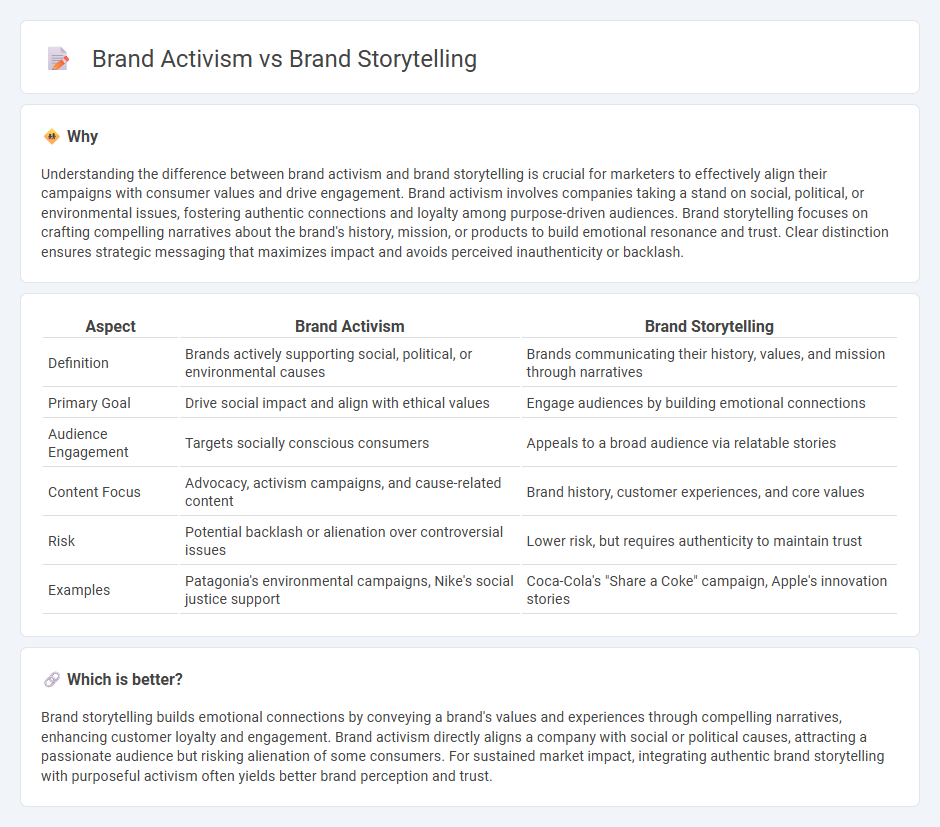
Brand activism involves companies taking a stand on social, political, or environmental issues to align their values with those of their audience, fostering deeper emotional connections. Brand storytelling focuses on crafting compelling narratives that highlight a brand's history, values, and mission to engage customers and build loyalty. Explore how these strategies can transform your marketing approach and strengthen consumer relationships.
Why it is important
Understanding the difference between brand activism and brand storytelling is crucial for marketers to effectively align their campaigns with consumer values and drive engagement. Brand activism involves companies taking a stand on social, political, or environmental issues, fostering authentic connections and loyalty among purpose-driven audiences. Brand storytelling focuses on crafting compelling narratives about the brand's history, mission, or products to build emotional resonance and trust. Clear distinction ensures strategic messaging that maximizes impact and avoids perceived inauthenticity or backlash.
Comparison Table
| Aspect | Brand Activism | Brand Storytelling |
|---|---|---|
| Definition | Brands actively supporting social, political, or environmental causes | Brands communicating their history, values, and mission through narratives |
| Primary Goal | Drive social impact and align with ethical values | Engage audiences by building emotional connections |
| Audience Engagement | Targets socially conscious consumers | Appeals to a broad audience via relatable stories |
| Content Focus | Advocacy, activism campaigns, and cause-related content | Brand history, customer experiences, and core values |
| Risk | Potential backlash or alienation over controversial issues | Lower risk, but requires authenticity to maintain trust |
| Examples | Patagonia's environmental campaigns, Nike's social justice support | Coca-Cola's "Share a Coke" campaign, Apple's innovation stories |
Which is better?
Brand storytelling builds emotional connections by conveying a brand's values and experiences through compelling narratives, enhancing customer loyalty and engagement. Brand activism directly aligns a company with social or political causes, attracting a passionate audience but risking alienation of some consumers. For sustained market impact, integrating authentic brand storytelling with purposeful activism often yields better brand perception and trust.
Connection
Brand activism and brand storytelling are interconnected as both utilize narrative techniques to convey a company's values and social commitments authentically, enhancing consumer trust and engagement. By embedding activism within compelling stories, brands create emotional connections that resonate deeply with socially conscious audiences. This integration strengthens brand identity and drives loyalty through meaningful dialogues around purpose-driven initiatives.
Key Terms
Brand Storytelling:
Brand storytelling creates emotional connections by weaving a brand's history, values, and mission into compelling narratives that resonate with target audiences. It leverages authentic customer experiences and consistent messaging across digital platforms to build brand loyalty and enhance recognition. Discover how mastering brand storytelling can transform your marketing strategy and deepen audience engagement.
Narrative
Brand storytelling centers on crafting compelling narratives that convey a company's values, history, and mission to build emotional connections with consumers. Brand activism involves integrating social or political causes into a brand's story to demonstrate commitment to societal change and influence consumer behavior. Explore how these distinct approaches shape audience engagement and brand perception further.
Emotional Connection
Brand storytelling creates emotional connections by sharing authentic narratives that resonate deeply with audiences, fostering loyalty and trust through relatable experiences. Brand activism, on the other hand, emotionally engages consumers by taking a stand on social, environmental, or political issues, aligning values with actions to inspire meaningful change and community support. Explore how integrating both strategies can amplify your brand's emotional impact and consumer engagement.
Source and External Links
Brand Storytelling: What It Is and Why It Matters - Acquia - Brand storytelling is a marketing approach that connects with audiences by making the customer the main character in a narrative that reflects relatable life experiences, building strong emotional connections and brand loyalty.
Brand storytelling: Creating a story that resonates - Sprout Social - Effective brand storytelling starts by understanding the customer as the protagonist, using narrative elements like characters and conflict to emotionally engage and build purpose-driven connections.
Brand Storytelling: How to Connect with Your Customers - Adobe - Defining your brand's mission and values is foundational to brand storytelling, providing a consistent, authentic narrative that resonates deeply with your target audience.
 dowidth.com
dowidth.com